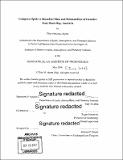| dc.contributor.advisor | Roger Summons. | en_US |
| dc.contributor.author | Myers, Elise McKenna | en_US |
| dc.contributor.other | Massachusetts Institute of Technology. Department of Earth, Atmospheric, and Planetary Sciences. | en_US |
| dc.coverage.spatial | u-at-we | en_US |
| dc.date.accessioned | 2018-03-12T19:30:59Z | |
| dc.date.available | 2018-03-12T19:30:59Z | |
| dc.date.copyright | 2014 | en_US |
| dc.date.issued | 2014 | en_US |
| dc.identifier.uri | http://hdl.handle.net/1721.1/114126 | |
| dc.description | Thesis: S.B., Massachusetts Institute of Technology, Department of Earth, Atmospheric, and Planetary Sciences, 2014. | en_US |
| dc.description | Cataloged from PDF version of thesis. | en_US |
| dc.description | Includes bibliographical references (pages 44-50). | en_US |
| dc.description.abstract | Stromatolites, columnar rock-like structures, are potentially some of the oldest, microbially mediated fossils visible in the rock record; if biogenesis is able to be confirmed for these ancient stromatolites, some being greater than 3 billion years old, these ancient stromatolites could be used to demonstrate the microbial community assemblages throughout ancient time. Hamelin Pool, Shark Bay, Australia is an ideal field site for this task, as stromtolites and modern microbial mats coexist and the microbial mats have been shown to contribute to the formation of the stromatolites. Comprehensive lipid biomarker profiles were determined in this study for non-lithified smooth, pustular, and colloform microbial mats, as well as for smooth and colloform stromatolites. Intact polar lipids, glycerol dialkyl glycerol tetraethers, and bacteriohopanepolyols were analyzed via liquid chromatography-mass spectrometry (LC-MS) coupled to a Quadropole Time-of-Flight (QTOF) mass spectrometer, while the previously studied fatty acids (Allen et al., 2010) were analyzed using gas chromatography-mass spectrometry (GC-MS) to prove consistent signatures. From the lipid profiles, sulfate-reducing bacteria and anoxygenic phototrophic bacteria and archaea could be inferred. The presence of the rare 3-methylhopanoids was discovered in a significant portion of the samples, which could add to the characterization of this molecule, which has only been concretely linked to oxygenic conditions for formation. In accordance with Allen et al. in 2010, 2-methyhopanoids were detected, as well as limited signals from higher (vascular) plants. While the lipid profiles for all sediment types were similar, there were some differences that are likely attributable to morphological differences. However, the overall similarities suggest microbial communities can be similar between non-lithified microbial mats and stromatolites. | en_US |
| dc.description.statementofresponsibility | by Elise McKenna Myers. | en_US |
| dc.format.extent | 56 pages | en_US |
| dc.language.iso | eng | en_US |
| dc.publisher | Massachusetts Institute of Technology | en_US |
| dc.rights | MIT theses are protected by copyright. They may be viewed, downloaded, or printed from this source but further reproduction or distribution in any format is prohibited without written permission. | en_US |
| dc.rights.uri | http://dspace.mit.edu/handle/1721.1/7582 | en_US |
| dc.subject | Earth, Atmospheric, and Planetary Sciences. | en_US |
| dc.title | Complex lipids in microbial mats and stromatolites of Hamelin Pool, Shark Bay, Australia | en_US |
| dc.type | Thesis | en_US |
| dc.description.degree | S.B. | en_US |
| dc.contributor.department | Massachusetts Institute of Technology. Department of Earth, Atmospheric, and Planetary Sciences | |
| dc.identifier.oclc | 1027723380 | en_US |
